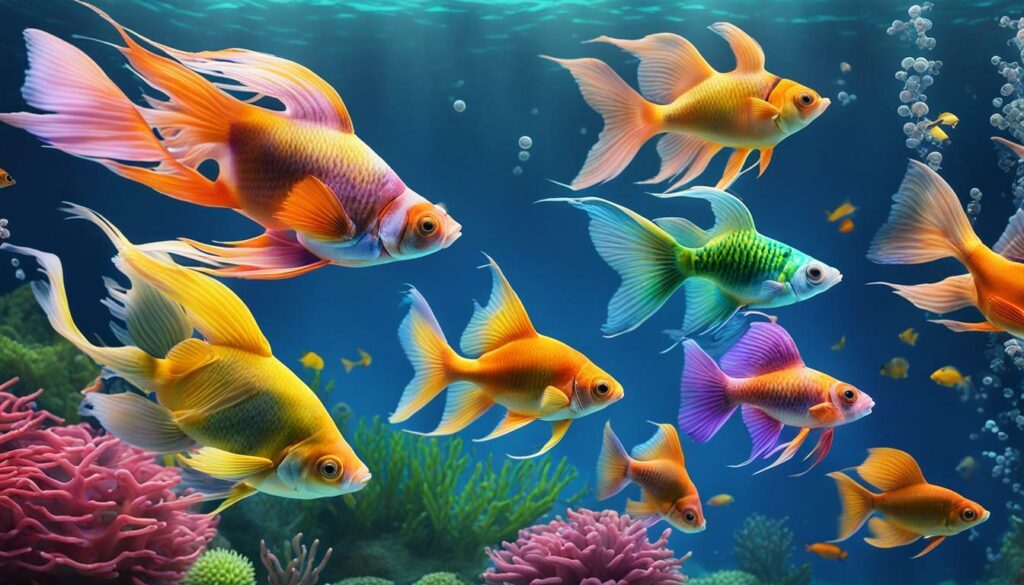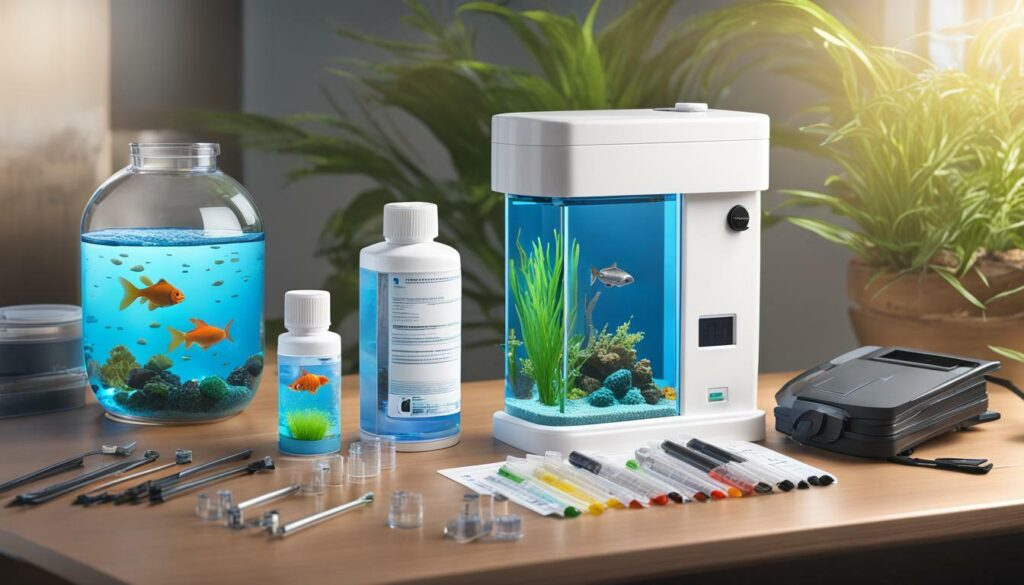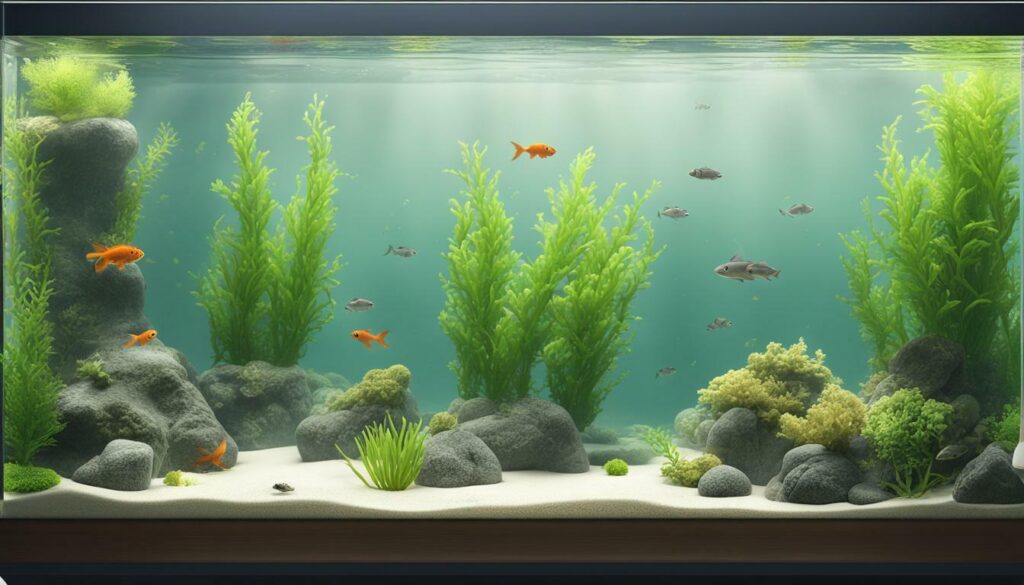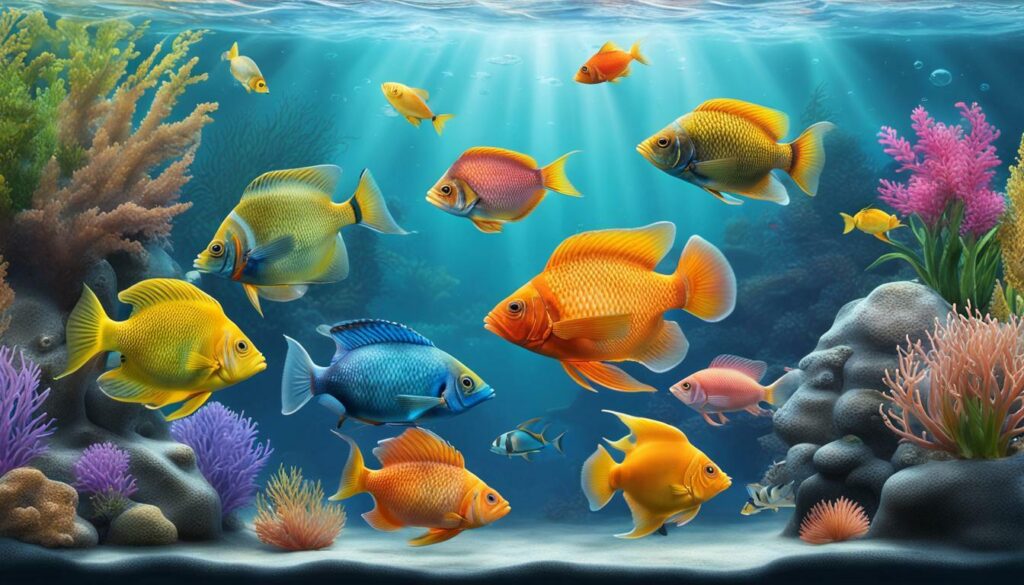Are your aquarium fish spending most of their time at the top of the water? This can be a cause for concern for many aquarium owners and may indicate an issue with their environment. At [company name], we understand the importance of maintaining a healthy tank for your aquatic pets. In this section, we will provide tips and solutions to help you create an optimal underwater environment for your fish, ensuring their health and happiness.
Key Takeaways
- Understanding fish behavior and feeding habits is crucial for maintaining a healthy tank
- Proper fish tank maintenance and monitoring water quality are essential for the wellbeing of your fish
Understanding the Behavior of Aquarium Fish at the Top of Water
Have you ever noticed your fish spending a lot of time at the top of the aquarium water? It may be useful to understand why certain fish species exhibit surface-dwelling behavior.
Fish Feeding Habits: Some fish, like guppies and bettas, tend to stay at the top of the water. They usually feed on insects or plant matter floating on the surface. So, if you own some of these species, their behavior may not be unusual or concerning.
Oxygen Levels: Oxygen is essential for the survival of your fish. If there is not enough oxygen in the water, fish will start gasping at the surface to get more air. Proper water flow, surface agitation, and aeration can help increase oxygen levels.
Water Quality: Poor water quality can cause fish to stay at the top of the aquarium water. High levels of toxins and pollutants in the water can stress them out, leading to a change in behavior. Regular water changes and using high-quality filters can help maintain good water quality.
It’s essential to note that not all fish that stay at the top of the water are in distress or unwell. Some species, such as Siamese fighting fish, thrive when living in water with low current flow. However, if you observe any changes in behavior or see any signs of distress, it’s essential to take action and ensure your fish are healthy.

Tip: Identify the surface-dwelling habits of your fish species and monitor their behavior regularly to spot any changes or signs of stress.
Maintaining Proper Water Quality and Conditions
Proper fish tank maintenance is vital to ensure a healthy and thriving aquarium. In this section, we’ll discuss the importance of maintaining proper water quality and conditions and offer tips on how to achieve it.
Regular tank maintenance, including monitoring water parameters such as temperature, pH levels, and ammonia levels, is essential to ensure the well-being of your fish. We recommend checking these levels at least once a week and keeping a record to track any changes and identify potential issues.
| Water Parameter | Optimal Range | Importance |
|---|---|---|
| Temperature | 75-82°F | Maintains metabolic rate and immune system |
| pH Levels | 6.5-7.5 | Affects fish health and ability to reproduce |
| Ammonia Levels | 0 ppm | Toxic to fish and can cause stress and illness |
In addition to monitoring water parameters, it’s crucial to regularly clean the tank, change the water, and ensure an optimal underwater environment. We recommend performing partial water changes of 25% every two weeks to remove harmful waste and replenish essential nutrients.

To maintain a balanced ecosystem, consider adding live plants and appropriate tank mates. Live plants provide natural filtration and promote oxygen production, while compatible tank mates can stimulate natural behaviors and reduce stress.
By following these tips and maintaining proper water quality and conditions, you can provide a healthy and happy environment for your aquarium fish.
Ensuring Adequate Oxygen Levels
One common reason why aquarium fish may stay at the top of the water is due to inadequate oxygen levels in the tank. Fish need oxygen to survive, and if the water in your aquarium doesn’t have enough oxygen, your fish may exhibit this behavior.
To ensure adequate oxygen levels in your tank, there are several methods that you can use. One effective way is to use an air pump. An air pump creates bubbles in the water, which helps to increase oxygen circulation. You can also use a water movement device, such as a powerhead or a filter, to create water flow and promote oxygen exchange. Proper placement of aquatic plants can also help to increase oxygen levels in your tank.
It’s important to keep in mind that different types of fish have different oxygen requirements. Some fish species, such as bettas and gouramis, are labyrinth fish, which means they have a special organ that allows them to breathe air from the surface. These fish may not need as much oxygen circulation as other fish, such as goldfish or tetras.

Regular monitoring of your tank’s oxygen levels is essential to ensure the health and wellbeing of your fish. You can use an oxygen testing kit to measure the oxygen levels in your tank water. If you notice that your aquarium has low oxygen levels, take immediate action to remedy the situation.
By taking the necessary steps to promote oxygen levels in your aquarium, you can provide a healthy underwater environment and reduce the likelihood of fish staying at the top of the water due to inadequate oxygen.
Addressing Potential Water Quality Issues
When your aquarium fish stay at the top of the water, it could indicate potential water quality issues. Poor water quality can lead to stress and health problems for your fish. Here are some common water quality issues and solutions to address them:
| Issue | Solution |
|---|---|
| High Ammonia Levels | Regular tank maintenance, including changing a portion of the water, reducing feeding frequency, and avoiding overstocking the tank. |
| High Nitrate Levels | Regular water changes, live plants, and proper filtration systems to remove excess nitrate. |
| High pH Levels | Regular testing and maintaining appropriate pH levels with natural or chemical buffers. |
| Low Oxygen Levels | Increase water movement through aeration, adding an air pump, or installing a filtration system to increase oxygenation. |
| Presence of Chemicals | Perform regular water tests and use water conditioners to neutralize any harmful chemicals. |
By regularly monitoring water quality and addressing any issues promptly, you can ensure a healthy and safe environment for your fish. It’s important not to neglect tank maintenance, as it can lead to significant health problems for your fish.

Providing a Balanced Diet for your Fish
Proper nutrition is crucial for the health and wellbeing of your aquarium fish. It’s essential to provide a balanced diet that meets the specific nutritional needs of different fish species.
Tip: Research the feeding habits of your fish and select a fish food that provides a balanced combination of protein, fat, vitamins, and minerals.
Overfeeding can lead to health issues such as obesity, constipation, and poor water quality. It’s essential to feed your fish in moderation and avoid leaving excess food in the tank.
Tip: Feed your fish small portions, 1-2 times a day, and remove any uneaten food after 5-10 minutes.

Some fish, such as herbivores, require a plant-based diet, while others, such as carnivores, require a meat-based diet. It’s essential to provide your fish with the right type of food to meet their nutritional needs.
Tip: Consider supplementing your fish’s diet with live or frozen foods such as brine shrimp or bloodworms for additional nutrients.
Providing a balanced diet can help promote healthy growth, vibrant coloration, and overall vitality in your fish. By following these tips, you can ensure your fish are getting the right nutrition they need to thrive in their underwater environment.
Creating Enrichment in the Tank
Providing your fish with an enriching underwater environment can greatly contribute to their happiness and wellbeing. Not only does it stimulate natural behaviors, but it also reduces stress and promotes healthy growth. Here are some ideas to help create an engaging environment for your fish:
- Use decorations to create a natural looking habitat. Incorporate rocks, driftwood, and plants to give your tank a more natural appearance. This can also provide hiding spots for your fish and make them feel safer.
- Add plants to your tank. Live plants not only provide oxygen but also create a more natural environment for your fish. They also offer places to hide and explore.
- Provide hiding spots. Rocks, caves, and other decorations can provide hiding spots for your fish. This allows them to retreat from the tank’s activity and create a sense of security.
Keep in mind that not all decorations are suitable for all fish species. Make sure to research the type of fish you have and what types of decorations they need.
Remember, creating an enriching underwater environment is crucial for both the physical and mental well-being of your fish.

“An enriching environment can stimulate natural behaviors and reduce stress among aquarium fish.”
Monitoring Fish Behavior and Health
Regularly observing your fish’s behavior is critical in identifying potential health issues. Signs of distress or illness to look out for include clamped fins, lack of appetite, abnormal swimming behavior, lethargy, and visible signs of injury or disease.
If you notice any abnormalities in your fish’s behavior or physical appearance, it’s essential to take action promptly. Isolate any sick or injured fish to prevent the spread of illness, and evaluate the water parameters to identify any potential issues with water quality or oxygen levels.
Consulting with a veterinarian specializing in aquatic pets can be a wise decision to ensure your fish receive the best possible care. Routine health check-ups are also crucial for maintaining fish health.
As responsible aquarium owners, we must prioritize the wellbeing of our fish by monitoring their behavior and taking prompt action when needed.

“Regular observation and swift action can prevent potential health risks for your fish.”
Introducing New Fish to the Tank
Introducing new fish to an existing aquarium can be a stressful experience for both new and existing fish. It’s important to take the necessary steps to ensure a smooth transition and minimize the risk of health issues or aggressive behavior.
The first step is to quarantine any new fish in a separate tank for at least two weeks. This helps to prevent the spread of potential diseases or parasites to the existing fish. During this time, monitor the new fish closely for signs of illness or stress.
Once the quarantine period is over, gradually introduce the new fish to the main aquarium. Start by placing the new fish in a plastic bag with water from the quarantine tank and float the bag in the aquarium for about 15-20 minutes. This will acclimate the fish to the temperature and water chemistry of the main tank. Afterwards, release the new fish into the aquarium carefully and observe their behavior for signs of aggression or stress. If any issues arise, separate the fish immediately.
It’s also important to consider fish compatibility when introducing new fish to the aquarium. Different species have different personalities and preferences, so research before adding new fish to the tank. Avoid overcrowding the tank, as this can cause stress and aggression among fish.

By taking the necessary precautions when introducing new fish to the tank, you can create a harmonious underwater environment for all of your fish. We recommend consulting with a veterinarian specializing in aquatic pets for additional guidance and recommendations.
Common Mistakes to Avoid
As aquarium owners, we want to provide the best care possible for our fish. However, even experienced owners can make mistakes that can negatively impact the underwater environment and the health of the fish. Here are some common mistakes to avoid:
| Mistake | Solution |
|---|---|
| Overfeeding | Stick to a feeding schedule and avoid giving too much food. Remember, fish have very small stomachs and can easily be overfed. |
| Neglecting water changes | Regularly change water to remove toxins, waste, and debris from the tank. Failure to do so can lead to poor water quality and affect the health of your fish. |
| Overcrowding the tank | Provide enough space for your fish to swim and establish territories. Overcrowding can lead to stress, aggression, and disease among fish. |
| Using inappropriate tank mates | Research appropriate tank mates that can coexist peacefully. Avoid putting aggressive or territorial fish together, as this can lead to fights and injuries. |
By avoiding these common mistakes, you can provide a healthy and enriching environment for your fish. Remember, keeping an aquarium requires attention and care, but it’s worth it to see your fish thrive.

Troubleshooting and Additional Tips
When aquarium fish exhibit unusual behavior, it’s important to identify the problem and take corrective action as soon as possible. Here are some common issues and troubleshooting tips:
| Problem | Troubleshooting Tips |
|---|---|
| Fin Rot | Check water quality, isolate infected fish, and treat with appropriate medication. |
| Swim Bladder Disorder | Feed your fish a high-fiber diet and avoid overfeeding. Consult with a veterinarian if the problem persists. |
| Parasitic Infections | Quarantine infected fish, use an appropriate medication treatment, and disinfect the tank and equipment. |
In addition to troubleshooting, there are some additional tips for maintaining a healthy and thriving aquarium:
- Perform regular water changes and tank maintenance.
- Choose appropriate tank mates and avoid overcrowding.
- Provide a balanced and varied diet.
- Add decorations, plants, and hiding spots for enrichment.
- Observe fish behavior for signs of distress or illness.
By following these tips and taking corrective action when necessary, you can create a healthy and happy environment for your aquarium fish.

Conclusion
We hope this guide has provided valuable insights into maintaining a healthy and happy underwater environment for your aquarium fish. By understanding the behavior of fish at the top of the water, maintaining proper water quality and conditions, and providing a balanced diet and enrichment activities, you can help your fish thrive.
It’s essential to avoid common mistakes and regularly monitor fish behavior and health to prevent potential issues from arising. By taking the time to introduce new fish properly and following proper procedures, you can ensure a harmonious underwater environment.
If you do encounter problems, our troubleshooting tips can help you identify and address them quickly. Remember, maintaining an aquarium is an ongoing process, and staying vigilant and proactive can ensure your fish live long, healthy lives.
FAQ
Q: Why are my aquarium fish staying at the top of the water?
A: There could be several reasons for this behavior. Some fish are natural surface dwellers, while others may be seeking oxygen, food, or experiencing water quality issues.
Q: How can I maintain a healthy tank environment for my fish?
A: Proper fish care and tank maintenance are crucial. Regularly monitor water quality parameters, clean the tank, provide adequate oxygen levels, and create an enriching underwater environment.
Q: What can I do to ensure proper water quality and conditions?
A: Regularly maintain the tank by monitoring temperature, pH levels, and ammonia levels. Clean the tank, change the water, and ensure an optimal underwater environment for your fish.
Q: How can I ensure adequate oxygen levels in my aquarium?
A: Use methods such as air pumps, water movement, and proper plant placement to provide enough oxygen for your fish.
Q: What are some common water quality issues that may affect fish behavior?
A: Poor water quality can cause fish stress. Regular water testing, appropriate filtration systems, and the use of water conditioners can help address these issues.
Q: How can I provide a balanced diet for my fish?
A: Understand the feeding habits of different fish species and select the right type of fish food. Feed them the appropriate amount and frequency to ensure their health.
Q: What can I do to create an enriching environment in the tank?
A: Use decorations, plants, and hiding spots to stimulate natural behaviors and reduce fish stress.
Q: How can I monitor my fish’s behavior and health?
A: Regularly observe your fish for signs of distress or illness. Consult with a veterinarian specializing in aquatic pets for regular health check-ups.
Q: How should I introduce new fish to my existing tank?
A: Acclimate new fish, quarantine them before introduction, and ensure compatibility among different species to maintain a harmonious underwater environment.
Q: What are some common mistakes to avoid in fish care?
A: Avoid overfeeding, neglecting water changes, overcrowding the tank, and using inappropriate tank mates to provide a better living environment for your fish.
Q: What troubleshooting tips and additional advice can you provide?
A: We’ll address specific concerns like fin rot, swim bladder disorder, and parasitic infections and offer guidance on identifying, treating, and preventing these problems.

